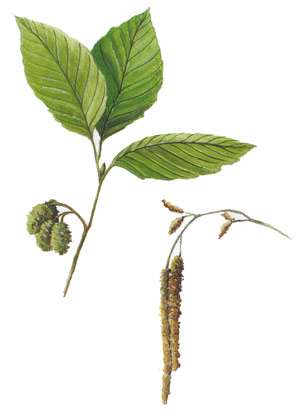
One way to find speckled alder in the spring is to listen for the plaintive fee-beo of the alder flycatcher. Whenever I’ve followed this little bird’s song to its source, it’s been in or near a patch of speckled alder. You don’t really need a flycatcher as your guide because alders are quite easy to find in any season, since many places with both wetness and sunlight will also have alders.
Speckled alders form such a dense canopy that sometimes the dimly lit ground beneath them is bare. A little muddy sometimes, too, but the flat, silty surface, devoid of vegetation, can easily be examined for the scattered holes that show that woodcocks have visited to probe for worms with their long bills.
It’s not easy to wander around in a stand of alders when they are young and in the impenetrable thicket phase. Only when the stems approach maturity, at 15 or 20 feet, is it possible to walk around in the interior, looking for signs of woodcock.
During the leafless season, the remnants of last year’s nests in various sizes and shapes confirm that many bird species appreciate the protection of a dense alder stand – not just the woodcock and alder flycatcher. The alder’s twigs and leaves are browsed by moose, hare, beaver, muskrat, and – when they are very hungry – deer. Its buds, seeds, and catkins are eaten by grouse, goldfinches, and redpolls. But the main value of alders to wildlife is as cover. Alders often fringe open marshes, slow streams, ponds, and lakes, so animals can quickly go from open feeding grounds to safety.
These water bodies benefit from alders as well, for alder roots are interwoven and matted, perfect for stabilizing soils that are subject to seasonal flooding. Alders are often planted along streams to prevent erosion, and they seem nearly ideal for the job: sun loving and fast growing, they flourish on a wide variety of soil types. Plus, they can convert nitrogen to a form usable by plants, making use of bacteria that inhabit nodules on their roots, just like legumes do. This is especially useful on boggy soils, which are typically infertile and acidic. Alder leaves are high in nitrogen, and their leaf litter contributes yet more of this nutrient to the soil.
This shrub grows in a very shrubby fashion, with 10 to 20 stems arising in a clump, surrounded by yet more stems that sprout from underground stems called rhizomes. Though individual stems are not long-lived, the clones persist for many decades.
The noticeable off-white speckles that give this alder its name are lenticels, pores used by all plants for gas exchange, and in this alder they show up on both small twigs and on the main trunk. Field guides often point out that alders are the only shrub that has two kinds of catkins in the winter: female catkins, empty of seeds, plus the next spring’s male catkins, preformed and ready to elongate and shed pollen before the leaves come out. In fact, there are three kinds of catkins. Just below the large male ones are the coming year’s very tiny female ones, which will enlarge and open in spring and, after bring pollinated, will make seeds that will mature and be dispersed in the fall.
The egg-shaped leaves of alder are somewhat rough. Their edges have large irregular teeth that in turn have smaller teeth. Between the straight parallel veins, a network of depressed veins gives each leaf a puckered surface.
A few years ago, a big alder swamp nearby that I keep an eye on slowly turned rusty brown over the course of the summer, much to my dismay. The few remaining leaves were dotted with shiny, oval-shaped beetles, which I soon learned were alder flea beetles, a native insect that has cyclic outbreaks. Both the larvae and the adults feed on alder leaves, which they chew up over many weeks. A couple of summers later, the swamp was fully green again, and there were no beetles.
What I keep hoping to see is another insect – the larva of a pretty butterfly called the harvester (Feniseca tarquinius, also known as the wanderer), which is the only butterfly species in North America that has carnivorous larvae. The caterpillars feed on alder blight aphids, and the adults eat the “honeydew” excreted by the aphids. It is said that the caterpillars can be half-buried in a mass of aphids. It’s not often that you’d wish for aphids, but I’d love to see a mass of them on alder, especially if I could watch them being eaten by butterfly larvae.


Discussion *